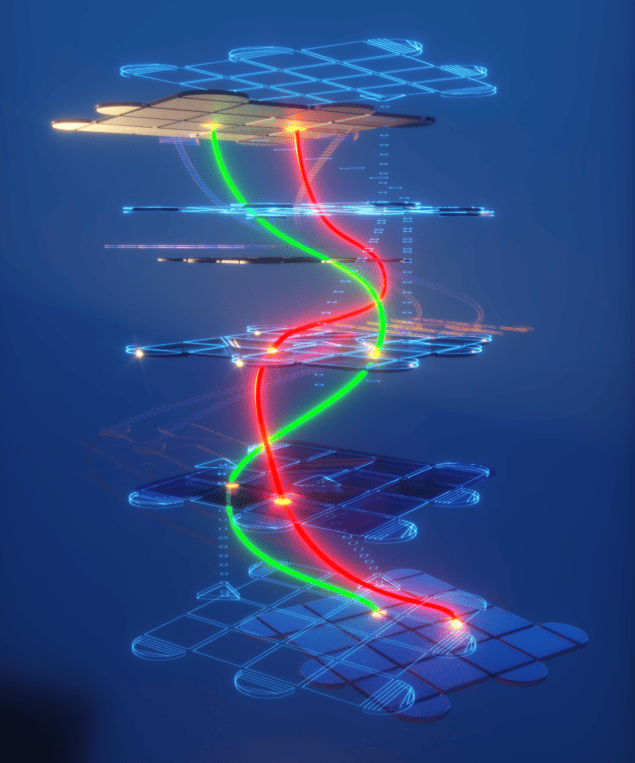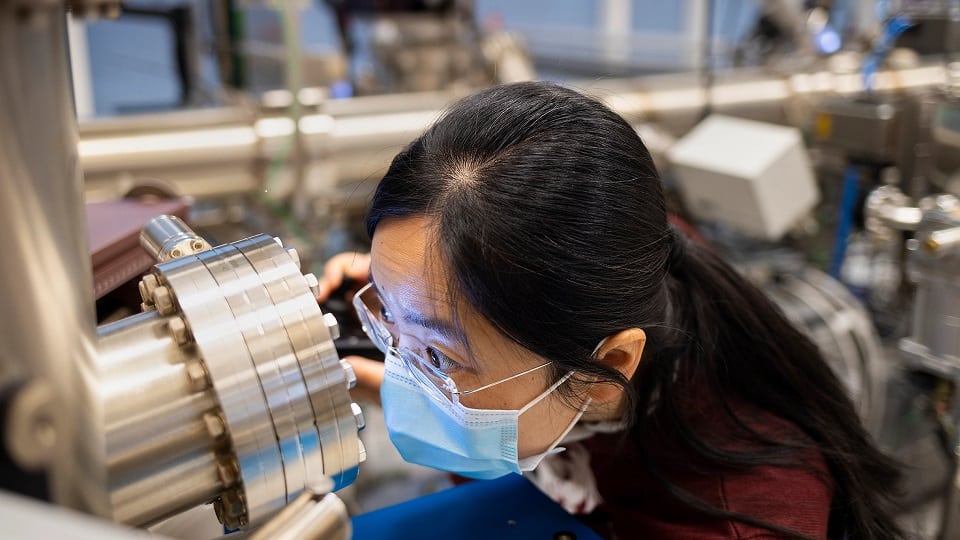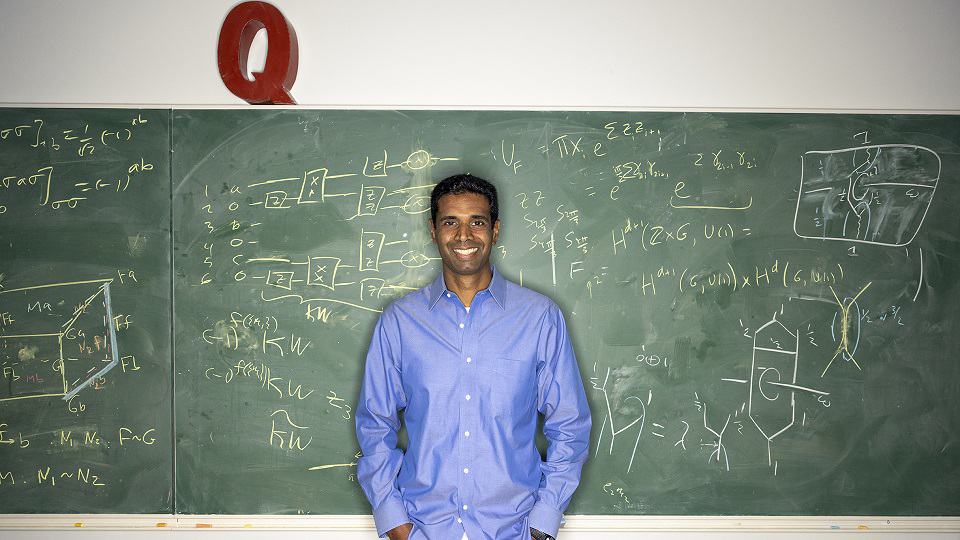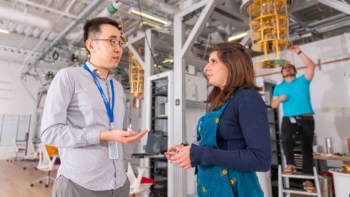
Errors are the Achilles’ heel of quantum computation, cropping up at random and threatening to ruin calculations. But they might, in principle, be tamed by encoding quantum information in a type of quasiparticle called a non-Abelian anyon. Evidence that such quasiparticles may exist has now been reported independently by teams at Google, Microsoft, the quantum-computing firm Quantinuum, and Zhejiang University in China.
The new reports “make a very intriguing advance in quantum computing”, says Jiannis Pachos, a physicist the University of Leeds, UK. “They are all things we have been waiting a long time to see,” agrees Steven Simon, a theorist at the University of Oxford, UK. “It’s a very exciting time for the field.” Still, Simon cautions that none of the results will transform quantum computing yet. “They all have shortcomings, which means there is lots of room for further work,” he says.
Errors in quantum computing
Quantum computers encode binary information in quantum bits, or qubits, which can take on values of 1, 0 or a superposition of the two. Various physical systems can act as qubits, including ions, photons and tiny components made from superconducting material. Quantum computations are performed by entangling many qubits so that their states are interdependent, then manipulating them according to some algorithm before reading out their final states.
The trouble is that random noise in the environment can change qubit states during the computation, making the calculation less reliable. This can happen in classical computers too, but there the problem is relatively easy to solve, for example by keeping several copies of each bit and assigning its value by majority rule. That won’t work for qubits, however, because quantum mechanics prohibits the copying of unknown quantum states, while the very nature of quantum computing requires that the qubit states remain unknown during the computation. As a result, researchers have had to search for more complicated methods of error correction.
Majorana particles to the rescue
An alternative approach is to use qubits that are more resistant to errors. In a paper written in 1997 (and published in 2003), physicist Alexei Kitaev showed that it might be possible to create error-protected qubits from hypothetical entities called Majorana particles. First proposed in 1937 by the physicist Ettore Majorana, these particles have a peculiar property: they are their own antiparticle.
No-one knows whether Majorana particles exist as fundamental particles. However, Kitaev showed that they can, in principle, be created from collective states of electrons called quasiparticles. He also showed that, if used as qubits, these states would be “topologically protected”, meaning that they can’t be randomly flipped by noise without “breaking” the quasiparticle, just as you can’t get rid of the twist in a Möbius strip without cutting it. Kitaev later proposed that these Majorana quasiparticles might be engineered as electronic defect states at the ends of quantum nanowires made from (for example) a semiconductor situated close to a superconductor.

These defect states are known as Majorana zero modes (MZMs), and they belong to a class of hypothetical (quasi)particles termed non-Abelian anyons. The “anyon” part signifies that the particles are neither fermions nor bosons – a property hypothesized by physicist Frank Wilzcek in 1982 and eventually observed (by teams in the US and France) in 2020 in electronic quasiparticles. Those observations, however, were of Abelian anyons, which are different from the non-Abelian variety Kitaev proposed for error-protected qubits. Specifically, if two non-Abelian anyons exchange places, their quantum states change in a detectable way even though the particles themselves are identical. Abelian anyons, in contrast, acquire no such observable change – only their quantum phase is altered.
The tangled web we weave
To make qubits from non-Abelian anyons, Kitaev suggested moving the anyons around to weave their trajectories together. This weaving process is called braiding, and it lets the anyons swap places in a way that alters their observable states. This can then be used to perform a logic operation. Enacting a quantum algorithm thus entails braiding non-Abelian anyons in a particular way, then reading out the result.
The main benefit of this set-up is that, in effect, the topology of the braiding “remembers” the qubit states. Errors can only arise if a braid is cut, which requires a lot of energy. Under these circumstances, the computation is said to be topologically error-corrected.
In 2018, researchers in China and the UK (including Pachos) simulated the braiding of non-Abelian MZMs in an optical system. In that experiment, the quantum states corresponded to photon polarization states. The most recent results take this a step further by showing how to implement the idea in real many-qubit quantum circuits.
The difficult task of making MZMs
While many groups have pressed ahead with making quantum computers from conventional, non-Majorana qubits supported by quantum error-correcting codes, Microsoft has pinned its quantum computing hopes on making topologically protected qubits from MZMs. “Microsoft’s longstanding belief is that engineering an error-protected topological qubit is the path to delivering quantum computing at scale”, says Chetan Nayak of Microsoft Quantum in Santa Barbara, California. “In engineering a topological qubit directly in the hardware, we will be able to create a new type of qubit that is fast, small, and controllable.”

But this has proved extremely hard, and the field has been dogged with claims that have subsequently crumbled under scrutiny. Part of the challenge has been to identify a clear signature of MZMs that distinguishes them from other quasiparticles. In their latest paper, Nayak and colleagues report evidence for what they think is a discriminating criterion for MZMs. This criterion is known as the topological gap protocol, and the Microsoft researchers say that their system – a thin film of semiconducting indium arsenide sitting below a 120-nanometre-wide strip of superconducting aluminium – passes it.
Making MZMs in such tiny objects would come with a big advantage. “In principle you could put a hell of a lot of them on a chip,” says Simon. However, the Microsoft paper is not yet peer-reviewed, and the claim will need to be checked carefully. “The hunt for MZMs has over-promised many times,” Simon adds. Though the new result looks promising, he suspects that, ultimately, claims for MZMs will only be accepted “if you can make and manipulate a qubit” from them. “Show me a qubit and then we’ll talk,” he says.
Anyons or simulations of anyons?
Meanwhile, teams at Google Quantum AI in the US, Zhejiang University in Hangzhou, China, and Quantinuum (formerly Honeywell Quantum Solutions and Cambridge Quantum Computing) in Germany and the US all claim to have made non-Abelian anyons from clever combinations of more conventional qubits – superconducting circuits for the Google and Zhejiang groups, and trapped ions for Quantinuum.

The question here is the meaning of the word “made”. In some sense, one could say that all three results involve not anyons as such but quantum simulations of them – a bit like simulating atoms on a classical computer. But the distinction is blurry. Because qubits are themselves quantum objects, they can be used to build exactly the same quantum wavefunction that an anyon would have. “It’s a fuzzy distinction between simulating matter and having matter,” says Simon. “But what they can say for sure is that they’ve made the wavefunction they want.”

The Google and Zhejiang teams used similar approaches on, respectively, a 25-qubit chip and a 68-qubit array. In both experiments, the anyons correspond to defects in a square lattice of interacting qubits, a little like dislocations in a crystal lattice. The lowest-energy (ground) state of this lattice structure consists of wavefunctions corresponding to Abelian anyons – and as Kitaev explained, this in itself can be used to construct an error-correcting qubit protected with an error-correcting code called the surface code.
To make defects corresponding to error-protected non-Abelian anyons, the researchers manipulated the interactions between neighbouring qubits in a controlled sequence. Both teams show that the resulting quasiparticles can be braided by moving them around one another. The Google researchers, led by Pedram Roushan and Trond I Andersen, also created a well-known quantum-entangled state (a Greenberger-Horne-Zeilinger or GHZ state) from their anyons – a proof of principle for how the quasiparticles can be manipulated.
Another route to non-Abelian anyons
The Quantinuum group, meanwhile, made non-Abelian anyons in a different way. Using the Honeywell 32-qubit H2 quantum processor, which holds ytterbium ions in an electromagnetic trap and alters their quantum states using lasers, they created a quasi-one-dimensional chain of interacting trapped-ion qubits.
Here, the anyons correspond to natural excitations of the ground state of the qubit system – which technically means they are not quasiparticles, since quasiparticles must be excited states. “The Majorana zero modes at the end of superconducting wires in the Microsoft experiment and the lattice defects in the Google experiment are non-Abelian defects,” emphasizes Ashvin Vishwanath of Harvard University, who collaborated with the Quantinuum team. “Unlike our experiment, they are not realized on top of true non-Abelian topological order.”

Nevertheless, all three results are “neat quantum simulations”, says Chris Monroe, a physicist at Duke University in North Carolina, US and chief scientist of the ion-trap quantum-computing company IonQ. He adds that such experiments could probably have been done on quantum-computing platforms years ago, but they have likely been motivated by recent interest in (and controversy about) MZMs in solid-state systems. “It’s a pretty interesting confluence of science and sociology,” he says.
Not yet universal
In Roushan’s view, the two approaches to braiding non-Abelian anyons – using superconducting qubits and trapped ions – are complementary. “There are advantages and disadvantages to each approach, but it is too early to say exactly how they will impact the respective developments,” he says.
In any event, both approaches are perhaps best regarded as proofs that non-Abelian anyon states – that is, the corresponding wavefunctions – exist. But Pachos warns that this is just a first step. “It is not clear yet how this can be moved to fault tolerance,” he says.
What is more, because these anyon states are made from conventional, error-prone qubits, no-one yet knows whether they can be made stable enough to truly act as topologically protected qubits. “To achieve fault tolerance, active error-correcting techniques will be required for our quantum simulation method,” acknowledges Song Chao, a physicist in the Zhejiang team. “A true breakthrough on the technology side will require showing that these protected qubits are more robust than the underlying qubits they are built from,” Vishwanath adds.

Majorana modes continue to elude
A further caveat is that none of the current experiments makes anyons with the right properties to provide qubits for “universal” quantum computing, which can embody any quantum algorithm. “They do have computational abilities, but none are universal,” Simon explains.
Still, all of these approaches “give a clear way to move forward”, says Pachos. He adds that “the field is very tense, as the conclusive discovery of [physical] non-Abelian anyons will lead to a Nobel prize”. But we are not there yet.
- This article was amended on 23/5/2023 to clarify Pedram Roushan’s comment on complementary approaches, and on 30/05/2023 to correct a reference to work done in 2018 by Jiannis Pachos and colleagues.



